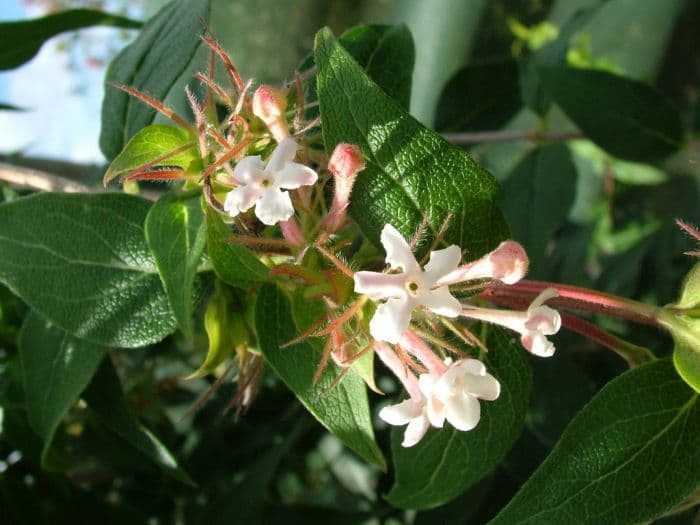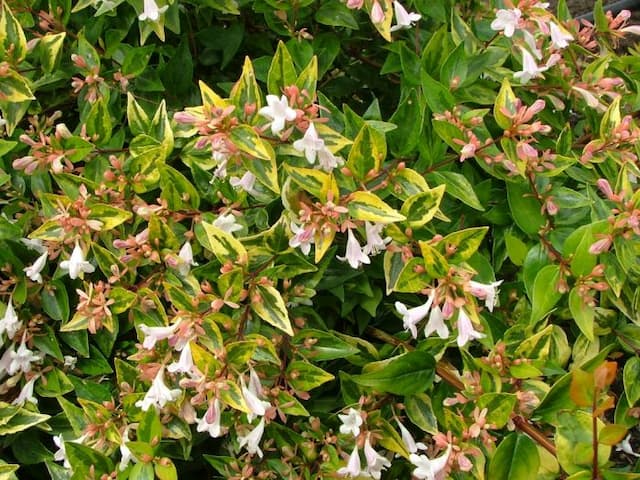Zabelia Zabelia triflora

ABOUT
Zabelia triflora is a striking plant characterized by its three-petaled flowers, typically delicate in appearance and arranged in a charming way that captures the gaze of onlookers. These blossoms often exhibit a soft color palette that enhances their subtle beauty. Surrounding the flowers are dark green leaves, which provide a lush backdrop and contrast that makes the blooms stand out even more. The foliage might showcase a glossy finish, emphasizing the plant's overall vitality. The leaves are generally shaped in a way that complements the floral arrangement, creating an aesthetically pleasing harmony between the different parts of the plant. This species often conveys a sense of grace and elegance, likely contributing to its appreciation among garden enthusiasts and landscape designers alike.
About this plant
 Names
NamesFamily
Caprifoliaceae
Synonyms
Zabelia, Three-flowered Abelia
Common names
Abelia triflora, Linnaea triflora, Zabelia dielsii, Zabelia tyaihyoni.
 Toxicity
ToxicityTo humans
Zabelia triflora, commonly referred to as Zabelia, has not been widely documented for its toxicity level to humans in scientific literature as of my last update in 2023. Therefore, the specific symptoms of poisoning, if any, are not well-characterized. It is always advised to exercise caution and avoid ingesting plants that have not been confirmed as safe for consumption, as there might be potential for adverse reactions.
To pets
There is limited information available on the toxicity of Zabelia triflora, commonly known as Zabelia, to pets specifically. Without concrete data, it is not possible to provide a precise account of the symptoms of poisoning that could occur if pets ingest this plant. As a precautionary measure, pet owners should prevent pets from consuming any plant material that has not been verified as safe. If ingestion happens and adverse symptoms are observed, it is recommended to consult a veterinarian.
 Characteristics
CharacteristicsLife cycle
Perennials
Foliage type
Deciduous
Color of leaves
Green
Flower color
White
Height
3-4 feet (0.9-1.2 meters)
Spread
2-3 feet (0.6-0.9 meters)
Plant type
Shrub
Hardiness zones
5
Native area
Asia
Benefits
 General Benefits
General Benefits- Aesthetic Appeal: Zabelia triflora, commonly known as bush honeysuckle, adds beauty to gardens with its delicate white flowers.
- Habitat for Wildlife: The plant offers a habitat and food source for various insects and birds, enhancing biodiversity.
- Shade and Cooling: Bush honeysuckle can provide shade in garden spaces, contributing to a cooler microclimate.
- Erosion Control: The root system helps stabilize soil and prevent erosion on slopes or in areas prone to soil displacement.
- Low Maintenance: Once established, bush honeysuckle is relatively low maintenance, requiring minimal care beyond occasional pruning.
- Seasonal Interest: Its blooming season adds seasonal interest to landscapes and may change color in autumn, providing year-round appeal.
- Drought Tolerance: Zabelia triflora is known for being drought-tolerant once established, making it suitable for xeriscaping and arid environments.
 Medical Properties
Medical PropertiesThis plant is not used for medical purposes.
 Air-purifying Qualities
Air-purifying QualitiesThis plant is not specifically known for air purifying qualities.
 Other Uses
Other Uses- Zabelia triflora, commonly known as Zabelia, can be used as a natural dye for fabrics, harnessing the pigments found in its leaves and flowers to create unique colors.
- The fibrous stems of Zabelia can be used in the production of paper, offering an alternative resource to traditional wood pulp.
- Due to its aromatic properties, the flowers of Zabelia can be added to potpourris and sachets to impart a pleasant fragrance to linens and clothing.
- Zabelia's dense foliage offers a natural shelter for small wildlife, providing a habitat for beneficial insects and small birds when used in landscaping.
- The nectar-rich flowers serve as an excellent source of food for pollinators, making Zabelia a valuable addition to butterfly and bee gardens.
- In certain regions, the leaves of Zabelia can be used as mulch, decomposing to enrich the soil with organic matter.
- As a decorative element, Zabelia's attractive blossoms and berries can be used in floral arrangements and wreaths.
- Zabelia can be planted as a privacy screen or hedge due to its thick growth habit, providing a natural barrier in garden settings.
- The plant's resilience to different soil conditions makes it useful in erosion control, where it helps to stabilize soil in vulnerable areas.
- When used in companion planting, Zabelia can play a role in pest management by distracting or repelling certain insect pests away from more sensitive crops.
Interesting Facts
 Feng Shui
Feng ShuiThe plant Zabelia triflora is not used in Feng Shui practice.
 Zodiac Sign Compitability
Zodiac Sign CompitabilityThe plant Zabelia triflora is not used in astrology practice.
 Plant Symbolism
Plant Symbolism- Adaptability: Zabelia triflora, also commonly known as shrubby abelia, can adapt to various soil types and climates, which makes it symbolic of flexibility and the ability to thrive in diverse conditions.
- Endurance: The plant's capability to withstand various environmental challenges symbolizes endurance and the strength to persevere.
- Growth: As shrubby abelia tends to grow and spread, it represents personal or spiritual growth and the continuous journey of learning and expanding one's horizons.
- Renewal: Often blooming with fresh flowers through the seasons, shrubby abelia symbolizes renewal, hope, and the promise of a new beginning.
- Protection: With its bushy nature, the shrubby abelia can offer shelter to birds and insects, thus symbolizing protection and the nurturing of those who are vulnerable.
 Water
WaterZabelia triflora, commonly known as Mock Orange, should be watered thoroughly, allowing the water to reach deep into the soil to encourage a strong root system. The plant prefers evenly moist soil, so it's important to water it when the top inch of soil feels dry to the touch, which generally means watering once or twice a week. During hot and dry seasons, it may require watering more frequently. It's best to adapt the watering frequency to the plant's needs, considering local climate and seasonal changes. For an average-sized plant, providing about half a gallon of water per week is typical, but this can vary based on the plant's environment and size.
 Light
LightMock Orange thrives in a location that receives full sun to partial shade. The ideal spot for this plant would be an area where it can bask in at least four to six hours of sunlight daily while also receiving some afternoon shade, especially in hotter regions. Proper light conditions are crucial for the plant to develop its best foliage and flower production.
 Temperature
TemperatureMock Orange can endure a range of temperature conditions, but thrives in temperate climates. It is hardy in USDA zones 5 through 8, typically withstanding minimum temperatures of -20 to -10 degrees Fahrenheit. Ideally, the plant should be grown where temperatures remain between 60 and 75 degrees Fahrenheit for optimal growth. It is important to protect the plant from extreme cold and harsh winds to prevent damage.
 Pruning
PruningPruning Mock Orange is necessary to maintain its shape, remove dead or diseased wood, and promote more prolific blooming. Prune immediately after the plant finishes flowering, usually in late spring or early summer, to shape the plant and thin out older branches. It's recommended to prune roughly one-third of the oldest stems to ground level every few years to rejuvenate growth.
 Cleaning
CleaningAs needed
 Soil
SoilZabelia triflora, commonly known as bush honeysuckle, thrives best in well-draining soil, rich in organic matter. A mixture of loam, peat, and coarse sand in equal parts creates an ideal environment. The soil pH should be slightly acidic to neutral, ranging from 6.0 to 7.0.
 Repotting
RepottingBush honeysuckle typically requires repotting every 2 to 3 years, depending on its growth rate and pot size. It's best to repot in the spring before the new growth starts.
 Humidity & Misting
Humidity & MistingBush honeysuckle prefers moderate to high humidity levels, ideally between 40% to 60%, to mimic its natural woodland habitat.
 Suitable locations
Suitable locationsIndoor
Provide bright, indirect light and moderate water.
Outdoor
Plant in partial shade, water regularly, and protect from strong winds.
Hardiness zone
5-8 USDA.
 Life cycle
Life cycleThe life cycle of Zabelia triflora, commonly known as Zabelia, begins with seed germination, which occurs under favorable moisture and temperature conditions in the soil. After germination, the seedling emerges, developing primary leaves and establishing a root system. As the plant grows, it enters a vegetative stage where it produces a rosette of leaves and starts accumulating resources necessary for flowering. Following the vegetative phase, Zabelia triflora enters the reproductive stage, where it develops clusters of white to pale pink flowers, attracting pollinators for sexual reproduction. Successful pollination results in the formation of fruits, which when mature, release seeds completing the cycle. Finally, the parent plant may die off after setting seed, or continue to grow and cycle through additional flowering and seeding phases depending on its perennial nature.
 Propogation
PropogationPropogation time
Spring-Early Summer
The most popular method of propagating Zabelia triflora, also known as bush honeysuckle, is through semi-hardwood cuttings. This is typically done in late summer. To do this, a gardener selects a healthy, semi-ripe section of branch about 4 to 6 inches (10 to 15 centimeters) long. The cutting should include multiple sets of leaves. The lower leaves are removed, and the base of the cutting may be treated with a rooting hormone to encourage root development. The cutting is then planted in a well-draining potting mix and kept under high humidity and indirect light until roots have developed, which usually takes several weeks. Once the cuttings have established a robust root system, they can be transplanted into their final location.

![Abelia [Sunshine Daydream]](/_next/image?url=https%3A%2F%2Fplants-admin.emdemapps.com%2Fimages%2Fplants%2F%2Fimages%2F604b61a1e9cdd.png&w=640&q=75)







